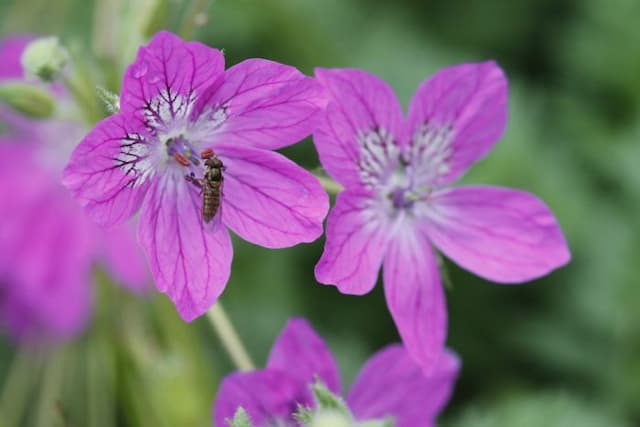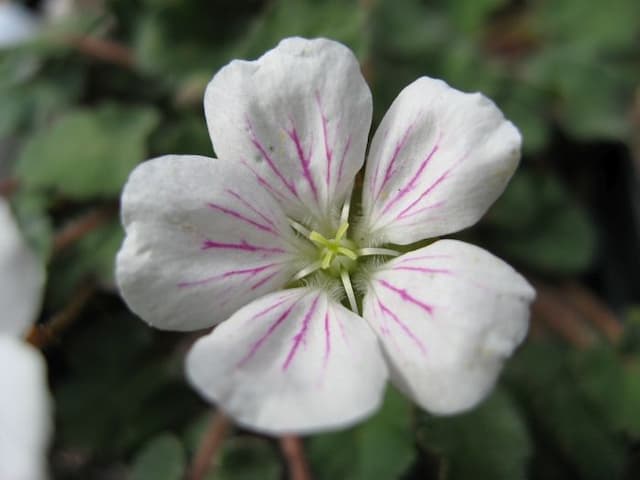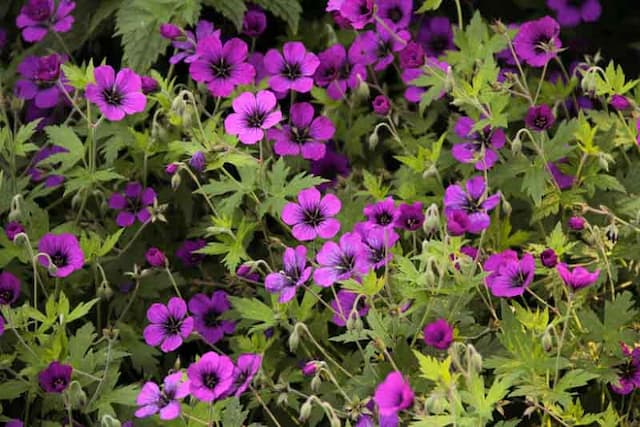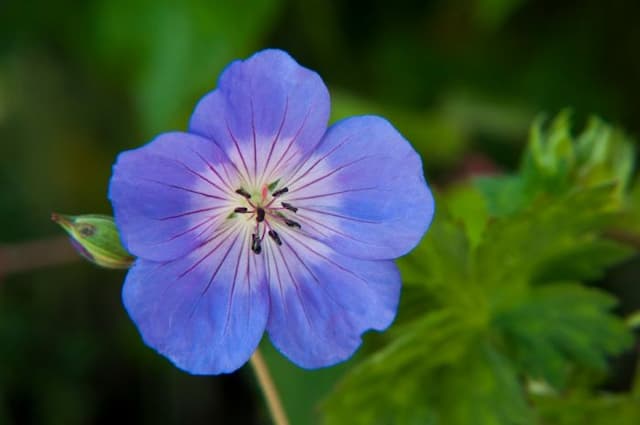Mourning Widow Geranium phaeum var. phaeum 'Samobor'

ABOUT
Geranium phaeum var. phaeum 'Samobor' is a variety known for its interesting foliage and flowers. The leaves of 'Samobor' are deeply lobed and have a lush, green color. What sets this variety apart are the distinctive maroon or dark purple blotches that mark the center of the leaves, giving them a unique and eye-catching appearance. These splotches add a touch of dramatic contrast against the softer green of the leaves. Come late spring to early summer, the plant is adorned with flowers that emerge on tall stems above the foliage. These blossoms are a nodding, dusky-purple shade and have an understated elegance. Each flower consists of five rounded petals that are slightly reflexed, creating a casual, yet sophisticated, cup-shaped form. The centers of the blooms typically exhibit pronounced, dark-colored stamens that add depth to the flower's overall look. 'Samobor' combines its striking foliage with these charming flowers to create an overall pleasing aesthetic, making it a favorite amongst gardeners who seek plants with both captivating leaves and blossoming beauty.
About this plant
 Names
NamesSynonyms
Dusky Cranesbill, Mourning Widow, Black Widow
Common names
Geranium phaeum 'Samobor'
 Toxicity
ToxicityTo humans
Dusky Cranesbill is generally considered non-toxic to humans and is not known to cause any significant symptoms of poisoning when ingested. However, as with any plant, individual sensitivities can vary, and it is always best to avoid eating plants that are not specifically meant for consumption to prevent any potential adverse reactions.
To pets
Dusky Cranesbill is generally considered safe and non-toxic to pets. It is not known to cause poisoning in dogs, cats, or other household animals if ingested. As with humans, it is always wise to discourage pets from consuming plants that are not intended as food to avoid the possibility of upset stomachs or other individual adverse reactions.
 Characteristics
CharacteristicsLife cycle
Perennials
Foliage type
Deciduous
Color of leaves
Green
Flower color
Maroon
Height
2 feet (60 cm)
Spread
1.5 feet (45 cm)
Plant type
Herb
Hardiness zones
4
Native area
Europe
Benefits
 General Benefits
General Benefits- Attracts Pollinators: 'Samobor' provides nectar and pollen for bees and other pollinating insects, encouraging biodiversity.
- Low Maintenance: The plant is known for its ease of care, requiring minimal attention once established in the garden.
- Shade Tolerant: It thrives in partially shaded areas where many other plants struggle, making it ideal for woodland gardens or shady borders.
- Ornamental Foliage: Distinctive marbled leaves offer visual interest even when the plant is not in bloom.
- Seasonal Interest: Produces attractive deep purple flowers in late spring to early summer, providing seasonal color.
- Drought Resistant: Once established, it can withstand periods of dry weather, reducing the need for frequent watering.
- Deer and Rabbit Resistant: Its foliage and flowers are typically unappealing to deer and rabbits, which can help prevent damage to the plant.
- Ground Cover: The plant can spread to form a dense mat, suppressing weeds and reducing soil erosion.
 Medical Properties
Medical PropertiesThis plant is not used for medical purposes.
 Air-purifying Qualities
Air-purifying QualitiesThis plant is not specifically known for air purifying qualities.
 Other Uses
Other Uses- Geranium 'Samobor' can be used as a natural dye source, the leaves and flowers may produce subtle shades of color when used in fabric dyeing processes.
- The dense foliage of Geranium 'Samobor' provides excellent ground cover, which can help prevent soil erosion in vulnerable areas.
- Floral arrangements can benefit from the inclusion of Geranium 'Samobor' for its unique foliage and dark, patterned leaves which add contrast and interest.
- In garden design, Geranium 'Samobor' can be used to create a 'living border' that defines garden spaces without the need for artificial or physical barriers.
- The leaves of the Geranium 'Samobor' can be used in potpourri mixes to contribute an earthy scent and interesting texture.
- Gardeners can use the plant to attract beneficial insects, such as bees and butterflies, which are important for pollination in the garden.
- Mourning Bride, as the plant is also known, can symbolize a visual remembrance in a garden dedicated to lost loved ones due to its somber colored flowers.
- Artists and illustrators may find inspiration in the intricate leaf patterns and deep purple flowers of Geranium 'Samobor' for their botanical drawings and designs.
- The plant can be part of a sensory garden, offering various textures from its leaves and flowers for tactile stimulation.
- Its ability to thrive in shady areas makes Geranium 'Samobor' a useful plant for creating green roofs or living walls in low-light urban environments.
Interesting Facts
 Feng Shui
Feng ShuiThe Mourning Widow is not used in Feng Shui practice.
 Zodiac Sign Compitability
Zodiac Sign CompitabilityThe Mourning Widow is not used in astrology practice.
 Plant Symbolism
Plant Symbolism- Unexpected Meeting: The Geranium phaeum 'Samobor', commonly known as Dusky Crane's-bill, often represents an unexpected encounter due to its ability to pop up and thrive in unexpected places in the garden.
- Friendship: Many geraniums symbolize friendship because of their amiable growing habits, forming close-knit clusters of plants, which can be likened to close groups of friends.
- Stalwartness: The hardiness and resilience of the Dusky Crane's-bill suggest a quality of stalwartness, as it persists and grows well even in less than ideal conditions.
- Ingenuity: The attractive and varied foliage of this geranium, especially the marbled patterns on 'Samobor' leaves, embodies creativity and ingenuity.
- True Comfort: The homely and comforting flowers of geraniums like 'Samobor' can represent the simplicity and solace of true comfort, reminiscent of a cozy, welcoming home.
 Water
WaterThe Mourning Widow Geranium should be watered deeply once a week, allowing the top inch of soil to dry out before watering again. This can typically translate to applying about 1 gallon of water for an outdoor plant in average conditions. However, during periods of extreme heat or drought, you may need to water more frequently, while in cooler or rainy weather, less often. Always avoid over-watering as this can lead to root rot. Keep in mind that indoor plants may require less water due to reduced evaporation.
 Light
LightThe Mourning Widow Geranium thrives in partial shade, ideally receiving morning sun and afternoon shade. The best spot for this plant is a location where it will be protected from the hot midday sun, as too much direct sunlight can scorch the leaves. This plant tolerates a range of light conditions but will bloom best with a few hours of sunlight each day.
 Temperature
TemperatureMourning Widow Geranium does well in a wide range of temperatures but prefers a range of 60 to 75 degrees Fahrenheit. It can survive minimum temperatures down to about 30 degrees Fahrenheit, making it suitable for outdoor growing in many regions. Protect the plant from frost to prevent cold damage and ensure that the temperature does not exceed 85 degrees Fahrenheit for prolonged periods as this can stress the plant.
 Pruning
PruningPrune the Mourning Widow Geranium to maintain shape and encourage bushier growth, usually cutting back by one-third after flowering in mid to late summer. This can be done each year after the main flowering period is over to promote new growth and new blooms in the following season. Remove dead leaves and spent flowers to keep the plant looking tidy and healthy.
 Cleaning
CleaningAs needed
 Soil
SoilMourning Widow prefers rich, well-draining soil with added organic matter and a pH range between 5.8 and 6.8. A mix of garden soil, compost, and peat or leaf mold will help ensure the right texture and fertility.
 Repotting
RepottingMourning Widow doesn't often require repotting; do so only every 3 to 4 years or when the plant outgrows its container.
 Humidity & Misting
Humidity & MistingMourning Widow tolerates a wide range of humidity levels but thrives best in moderate humidity, without the need for any special humidity adjustments.
 Suitable locations
Suitable locationsIndoor
Place in bright, indirect light with moderate watering.
Outdoor
Plant in partial shade, shelter from harsh sun.
Hardiness zone
4-8 USDA
 Life cycle
Life cycleThe life cycle of 'Samobor' Mourning Widow (Geranium phaeum var. phaeum) begins with seed germination in early spring, where warmth and moisture trigger the dormant seeds to sprout. The seedlings grow and develop a rosette of leaves close to the ground, establishing a root system. As they mature into vegetative plants, they form distinct, patterned foliage and erect stems. During late spring to early summer, the Mourning Widow blossoms, producing small, dark-purple to maroon flowers that are attractive to pollinators. After pollination, the plant sets seed, which mature by late summer, ensuring propagation for the next generation. The plant then enters a period of dormancy in late autumn or winter, depending on the climate, dying back to the ground to conserve energy until the next growing season.
 Propogation
PropogationPropogation time
Spring to Summer
The most popular method of propagating the Geranium phaeum 'Samobor', commonly known as the Dusky Cranesbill, is by division. This is usually done in early spring or autumn. To propagate by division, carefully dig up the parent plant, ensuring a generous amount of root is attached. The clump should then be gently pulled apart by hand or cut with a sharp knife into smaller sections, each with several shoots and a healthy root system. These divisions can then be immediately replanted in the garden, spaced about 12 to 18 inches (30 to 45 centimeters) apart, and watered in well. This method is straightforward and typically results in a high success rate, with the new plants establishing quickly and blooming within a season or two.









